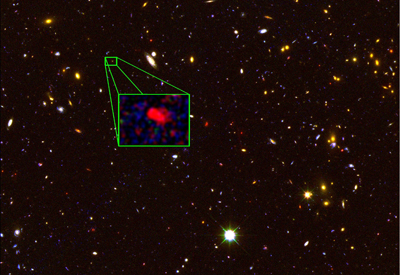







| BOOKS | F. A. Q. | ARTICLES | TALKS | ABOUT KEN | DONATE | BEYOND OUR KEN |
|---|
By Ken Croswell
Published on Physics World (October 23, 2013)

Credit: V. Tilvi (Texas A&M), S. Finkelstein (UT Austin), the CANDELS team, and HST/NASA.
Astronomers in the US have measured the distance of the farthest known galaxy, finding that its light took 13.1 billion years to reach Earth�which means the light was emitted just 700 million years after the big bang. Although the galaxy is much smaller than the Milky Way, it is forming stars at a much faster rate. The discovery provides important new information about the epoch of reionization, the ancient era when the neutral gas between galaxies became ionized.
To observe the farthest galaxies, astronomers exploit the universe's expansion, which stretches�or redshifts�the light waves of distant objects to longer, or redder, wavelengths. But dust can also redden light, so a red color alone does not guarantee that a galaxy lies at the edge of the observable universe.
"The problem had been, over the previous few years, people have been trying to confirm these really distant galaxies�and for the most part coming up empty," says Steven Finkelstein, an astronomer at the University of Texas at Austin.
Confirmation of a far-off galaxy's distance requires measuring the redshift of lines in the spectrum of light that it emits. This means that astronomers face the challenge of obtaining the spectrum of a faint object. So for two nights in April, Finkelstein took aim at 43 red objects in the constellation Ursa Major with one of the largest telescopes in the world, the 10-metre Keck I telescope atop Mauna Kea in Hawaii. A year earlier, this telescope had received a more sensitive spectrograph, which made Finkelstein's observations possible.
Finkelstein searched the spectra for a line from Lyman-alpha emission. This radiation arises when an electron falls from the n = 2 to the n = 1 state of hydrogen, which is the most abundant element in the cosmos. This spectral line normally emits far-ultraviolet radiation at a wavelength of 1216 angstroms (121.6 nanometers), but because of the hoped-for redshifts, Finkelstein obtained his spectra at near-infrared wavelengths instead.
In 42 of the 43 spectra, Finkelstein saw no lines. "I was disappointed, I think�until I figured out the redshift of the one we did see and realized it was the most distant one." That galaxy, bearing the unwieldy name z8_GND_5296, has a Lyman-alpha line at a wavelength of 10,343 angstroms (1.0343 microns), a 751 percent increase over the rest wavelength, which means that the galaxy's redshift is 7.51. It is 40 million light-years more remote than the previous record holder, at redshift 7.215.
"That alone is remarkable," says Dominik Riechers, an astronomer at Cornell University in Ithaca, New York, who was not part of the research team. "It's a significant step in terms of distance, and it's a very unusual galaxy."
Because of its great distance, we see the galaxy as it was just 700 million years after the big bang. At that time galaxies were small because they had yet to grow larger. All the galaxy's stars put together weigh only a billion times more than the Sun, a fraction of the Milky Way's stellar mass.
But the galaxy is growing up fast. Its stars have already enriched it with heavy elements. Furthermore, it is undergoing a "starburst": Finkelstein and his colleagues calculate that the galaxy converts about 330 solar masses of gas into stars each year�roughly 100 times the Milky Way's rate. At that pace, the galaxy could have created all of its stars in only 3 million years.
That's much too fast for Abraham Loeb, who chairs the astronomy department at Harvard University. "The thing that makes me worried is that you really need the entire galaxy to be dense and synchronized" in order for it to make all its stars so quickly. Loeb says a group of galaxies might lie in front of the galaxy and gravitationally amplify its light, making it seem more prolific than it really is.
But Finkelstein says another distant galaxy, at redshift 7.21, is also a vigorous star creator. "We think that finding two of these in a relatively small region of the sky is telling us that in the early universe there are more sites of very intense star formation than we had previously thought possible," he says.
In any event, the galaxy yields insight into the ancient universe. In particular, 700 million years after the big bang, at least some of the gas between the galaxies must have made the transition from neutral to ionized. Otherwise, Finkelstein would not have detected the galaxy's Lyman-alpha radiation, because neutral hydrogen gas scatters it away. Indeed, that may be why he failed to find this radiation from other distant galaxies, some of which may be even farther away.
Alternatively, the galaxies themselves may be to blame. They may harbour so much neutral hydrogen gas that it traps all the Lyman-alpha radiation they generate. The starburst in the one galaxy whose distance Finkelstein measured might have blasted holes in the gas, so Lyman-alpha radiation could escape the galaxy and reach telescopes on Earth.
The astronomers report their discovery today in Nature.
Ken Croswell earned his Ph.D. in astronomy from Harvard University and is the author of The Alchemy of the Heavens and The Lives of Stars.
"An engaging account of the continuing discovery of our Galaxy...wonderful." --Owen Gingerich, The New York Times Book Review. See all reviews of The Alchemy of the Heavens here.
"A stellar picture of what we know or guess about those distant lights."--Kirkus. See all reviews of The Lives of Stars here.
| BOOKS | F. A. Q. | ARTICLES | TALKS | ABOUT KEN | DONATE | BEYOND OUR KEN |
|---|